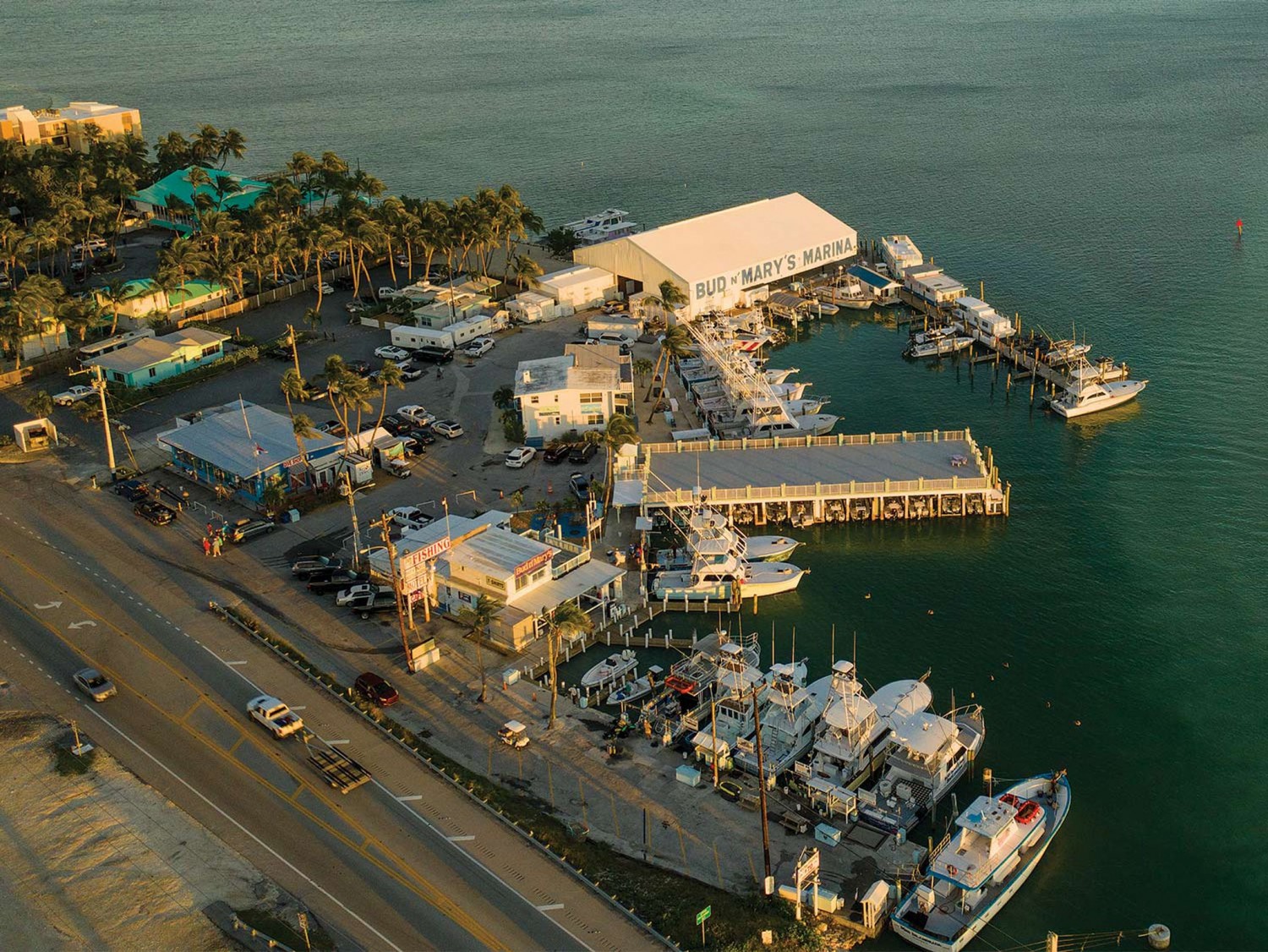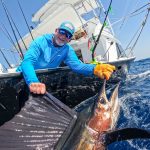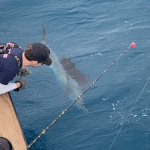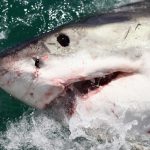Article Courtesy: marlinmag.com | Originally Published: 2/12/2021 | Click here for original article
A History of Bud N’ Mary’s in the Florida Keys
That old axiom—location, location, location—certainly applies to Bud N’ Mary’s Marina in Islamorada, Florida. It’s a short boat ride from where the Atlantic Ocean meets the Gulf of Mexico and the nation’s longest coral reef, at the crossroads where the Atlantic merges with Florida Bay and the Everglades. A destination where, prior to the coronavirus shutdown, 200 people per day came through the tackle shop to go charter fishing, destined to join the hundreds more featured in the smiling-face photos that decorate the walls of that same shop.
This unique location is why it has endured for more than 80 years, explains Bud N’ Mary’s current owner, Richard Stanczyk. “Not only is it where the Atlantic meets the Gulf of Mexico, but with our location at Tea Table Bridge, we are only minutes from Alligator Reef light and a 45-minute run to what the locals call the Humps—seamounts in 300 to 600 feet of water. It’s almost impossible to go fishing here and not catch anything.”
Location was also the motivating factor for the 15 charter boats, 20 backcountry guides, and a dive and headboat named Miss Islamorada that call Bud N’ Mary’s home. “I know I am prejudiced, but to me, it’s the best charter dock in Florida. Always has been,” Stanczyk adds. “Islamorada—along with Bud N’ Mary’s—has more IGFA records than any one place in the world.” And it began with what most people say was one of the deadliest and most destructive hurricanes ever to hit Florida.
The great Labor Day storm of 1935 socked the middle Keys with 185-mile-per-hour winds, shredding shirts off mens’ backs as they clung to what little vegetation remained. With an 18-foot surge, the storm killed an estimated 500 people and destroyed 40 miles of Henry Flagler’s railroad to Key West, as well as the fabled Long Key Fishing Club. Afterward, oceanfront parcels went for bargain prices, the reason why Capt. Everett Fowler was able to purchase the natural boat basin that would become the site of Bud N’ Mary’s at mile marker 79.8 on the Overseas Highway. Fowler built his fish camp, motel and marina around 1937. Then, in 1944, New Englanders Bud and Mary Stapleton came along. Although they knew little about saltwater fishing, they recognized the opportunity. After inheriting the oceanfront parcel, they renamed the place Bud N’ Mary’s and, according to Bud, by 1950 they had five guide boats operating, along with a motel and tackle shop with a second-floor apartment for him and his wife.
For the first few years, inshore guides had the place to themselves, but that was before Capt. Don Gurgiolo came along and talked Bud into letting him build a dock for his 26-foot Lyman, Gonefishin. The boat was rigged with two kitchen chairs bolted to the deck for fighting sailfish and was the first of five Gonefishin boats in Gurgiolo’s 50 years at the marina. Arriving in 1949, the pilot-turned-fisherman chose Islamorada and Bud N’ Mary’s Marina after recognizing its proximity to good fishing, explains his daughter, Tammie. A pioneer of light-tackle billfishing techniques, he began chumming and cast-netting live ballyhoo to use as sailfish bait. Up until his discovery and success—which everyone quickly emulated—live ballyhoo were rarely used to catch sailfish, Tammie says.
Capt. Allan Starr was docked at Bud N’ Mary’s then and followed Gurgiolo’s lead, using a 16-foot fast-sinking cast net to catch the skittish ballyhoo. But instead of taking them to deeper water, he decided to stay inshore and fish for what was causing the bait to shower. One of the few captains in the late 1960s whose boat possessed a tuna tower, from his lofty perch Starr saw that mackerel and small tuna would cause the baits to swim in a circular motion, but every now and then, there would be a prolonged or sustained run from deep to shallow water forced by something bigger and darker—sailfish.
No one believed you could catch sailfish in 15 feet of water back then, but Starr did, says his then-mate, Capt. Alex Adler, now the veteran captain of Kalex at Bud N’ Mary’s. The witty fisherman proved his point during the Islamorada Charter Boat Association Sailfish Tournament in 1972. Bored after two days of trolling dead bait, he withdrew from competition to chase sailfish his way. Starr would hang offshore fishing in the traditional manner until he spotted the bait showering inshore, Adler says. Issuing terse “lines in” and “spinning rods ready” orders, he would head full-throttle into the melee of frenzied ballyhoo and sails, which he described as “organized confusion in mass form, punctuated by chaotic behavior.” In the end, Starr caught 23 sailfish in two days, which was three more than the combined 40 boats caught collectively in four days.
The 1960s was a time of change for Bud N’ Mary’s. Not only did Hurricane Donna decimate the docks in 1960, but the Stapletons sold the marina to a retired New York jeweler named Jack Kertz, “who took the place from its mom-and-pop roots to pretty much what you see today,” adds Stanczyk, the fourth and longest-serving owner, of 42 years.
Born in St. Louis in 1945, Stanczyk grew up in North Miami in the 1950s. His father never fished; he was a tough-as-nails two-time Olympic medalist in weightlifting who got seasick at the mere mention of the ocean. But his maternal grandfather was a fisherman, and it was he who introduced Stanczyk to his lifelong passion. An astute businessman, his grandfather owned lending institutions in the Midwest and had the means to spoil his 10-year-old grandson with an 8-foot outboard-powered pram, and later, a 21-foot Fibercraft with an 80 hp inboard-outdrive that Stanczyk took to Bimini at age 15.
“I was always fishing and camping overnight with friends on the uninhabited islands around Miami,” he explains. Indeed, Billy Broach, the manager of Bud N’ Mary’s, was with him the day he fueled at Haulover Park Marina and asked how far it was to Bimini. “I will never forget the guy pointing and saying, ‘Just go that way for 60 miles, and keep your compass heading on E,’” Broach says. Figuring it was just another uninhabited island, you can imagine their surprise at meeting locals such as Harcourt Brown, the owner of Brown’s Hotel and Marina. To pay for his frequent Bahamas excursions, Stanczyk got a job parking cars at the Fontainebleau Hotel and running errands for celebrity clientele such as mobster Meyer Lansky. “The tips were great, but what I really learned was how to network. Later on, that helped me get charter bookings from hotel concierges,” he says.
Stanczyk tried to emulate his grandfather by majoring in economics and then accounting at the University of Miami. “I chose accounting to please my grandfather, but on his dying bed, he cut me free from a life I was ill-suited for. I was working then for a CPA, and as soon I could manage, I quit and bought a rundown bar and restaurant, which I turned into a success. At the same time, I was running my first charter boat, which I bought from James L. Knight, at that time the publisher of the Miami Herald,” he says. Docked at Pier 5, it was like Bud N’ Mary’s on steroids.
Running the bar at night and fishing by day, he was dangerously close to burning out, so he sold the business for what he called “a ridiculous amount” in 1977 and did what any sensible person would do: He bought an interest in an Alaskan gold mine. “I was living in a 4-by-8-foot shed with plastic for a roof. I lasted eight months,” he says with a laugh. Leaving a failed marriage and the mine behind, he headed back to Miami with a dream to create his own version of Pier 5 in the Florida Keys.
His first introduction to Bud N’ Mary’s came about almost by accident. In the 1960s, he owned a 60 mph 29-foot Cary, which he would take to the Bahamas. “I could leave Miami and be fishing off Bimini in an hour,” Stanczyk says. In 1969, he found himself partying at a calypso beach bar with a woman named Mary, whose stage name was Sexy Mama. One thing led to another, and he invited her and her girlfriend to fish the Native Tournament. “My mate then was 15-year-old Percy Dottin, who rigged a schoolie dolphin that we hooked a blue marlin on. Percy had several shots at it, but we lost it after seven hours. I was so upset, I started drinking and blacked out on the dock. I remember someone shaking me awake. It turned out to be Harold Adler, Alex’s dad, offering me a bunk on Miami Herald.”
The two stayed in touch, and the next year, Adler contacted Stanczyk, asking to borrow the Cary to fish the Islamorada Sailfish Tournament because Kalex was disabled. “The deal was that Jimmie Albright would run it while I mated,” Stanczyk says. It was his first introduction to light-tackle billfishing. They fished 16-pound-test with mono leaders and ended up winning. It was also his introduction to Bud N’ Mary’s Marina. “The place registered with me,” he says. “There weren’t many offshore boats, but all of them had first-class captains, including Jimmie Albright.”
In his almost three decades at Bud N’ Mary’s, Albright fished with everyone, from President Harry Truman to actor/anglers Jimmy Stewart and Myrna Loy to long-standing client and baseball star Ted Williams. The two men became friends after Albright took the Hall of Famer bonefishing in 1950 or so, Stanczyk says. “Before his death in 1988, Jimmie gave me a reel of film that I filed away, only to discover years later it’s one of the only surviving copies of the Sears Roebuck documentary about Ted Williams and tarpon fishing in Islamorada.”
Albright and Adler introduced Stanczyk to Jack Kertz, the owner of Bud N’ Mary’s. Years later they would meet again when Stanczyk was scouting property in the Keys. As much a businessman as charter captain, he had a vision of what Bud N’ Mary’s could be and set about making it successful, not only for himself but also for the more than 45 families who depend on the marina for their livelihood, says his son, Nick, now a well-respected captain in his own right. The effort was magnified after Stanczyk gave up alcohol. “At 10 a.m. on March 7, 1990, I quit drinking for good after my oldest son, Rick, who was then just a little guy, overheard me having an argument with his mother. I remember catching a reflection in the mirror of the man I had become, and I fell to my knees, asking for God’s help. It was my epiphany.”
Capt. Scott Stanczyk began running Catch 22 for his older brother in 1979. The good-natured Scott has always been willing to take his brother, nephews and their friends fishing. In 2003, Scott led an experimental daytime expedition for swordfish initiated by Richard and inshore guide Capt. Vic Gaspeny, who Richard says has a “fetish” about swordfish. “So off we go, stopping on the edge of the continental shelf in 1,000 feet to let out a 12/0 with a lead downrigger weight and a whole squid. The current was running so hard, we couldn’t hold bottom. So after a while, we locked it up and started reeling it in. Everyone on the boat took their turn. Finally we got the rig back—with a 60-pound swordfish dead on the hook. Now what do you think would have happened if that fish hadn’t been there? We might never have gone swordfishing again,” Scott muses.
The 1968 book Fishing the Caribbean by Venezuelan cardiologist Dr. Ruben Jaen inspired the group. They learned that broadbills were being caught in the Caribbean at night by drifting baits near the surface and during the daytime by fishing on the bottom. Jaen based his assumptions on the Cuban commercial swordfish fishery, which developed in the 1960s. The fishermen there were catching swordfish by drifting large squid 200 feet below the surface at night with lighted buoys.
Richard and Scott Stanczyk spent hundreds of hours talking about the problems of catching them in the Florida Keys, with its rocky bottom and current—the question being how to tame the current while keeping the sport in swordfishing. It was no easy task, Richard says; there were a lot of variables to overcome. These included determining where to fish—they favor 1,500 feet—to what baits work best—they found that dolphin and bonito bellies work better than squid because the swordfish can’t whack them apart as easily—to using Stanczyk’s unique breakaway concrete weights to keep the bait in the strike zone off the bottom. After 12 years and participating in the capture of 500 swordfish, including seven in one day, they just quit. “I still think they are the ultimate offshore challenge but not on electric reels,” he explains.
Capt. Nick Stanczyk graduated with a degree in film production from the University of Miami, and although he never thought he would be running charters or a marina because of the sacrifices he knows all to well, he has ended up doing just that. He and his brother, Rick, have assumed an ownership role in Bud N’ Mary’s, which has allowed Richard to take a backseat, although he still comes in every day to greet people and oversee the books, says Nick, whose day job is running the 37-foot Freeman, Broad Minded. Like his brother, Nick had nothing given to him. He came up the hard way, from operating the slowest boat in the marina to the fastest one in town.
“Just like the guys who fished here over time, captains like Don, Jimmie, Allen, Rick DeFeo, Skip Neilsen, Alex Adler, and Scott too, were the best of the best,” Richard says. “They figured out better ways to join two lines together and experimented with new techniques for catching billfish on fly. They were pioneers, not just of the Humps here off Islamorada, but places like Cozumel, Mexico, Brazil and Costa Rica. The essence of Bud N’ Mary’s has always been about captains passing on the knowledge to the next generation, showing by example how to be the best fishermen. I know the marina is in good hands because Rick and Nick will carry on that legacy long after I’m gone.”
And what a legacy it has become.






